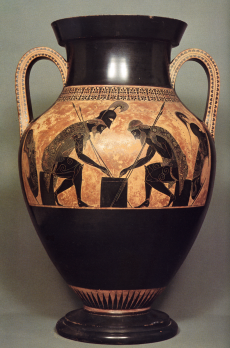
Email: EllaTournes@bexleygs.co.uk
Total Article : 45
About Me:Sixth form student currently studying English Literature, Drama and Theatre Studies, Classical Civilisation and History.

Whether an artist is 'fine' or not can generally be judged by the quality of their work. Aesthetically pleasing vases show evidence of realism, narrative technique, movement, appropriate perspective and torsion, appropriate depiction of amount of subject matter, and a clear point for the viewer to focus on. Innovation is also important to being considered a 'fine artist' among one's contemporaries.
Exekias could be considered one of the finest artists of his time, as he is arguably the most skilled and the most innovative. The artist Exekias is said to have ‘transcend(ed) limitations of black-figure technique’ - he experimented with new, different shapes, and devised unusual techniques to enhance the beauty of his vases (like the use of a coral-red slip to enhance colour in the Dionysus cup). He was also one of the first artists to ever put a name to his work by signing it – an innovative gesture reflected in modern art today - signatures are often used to guarantee authenticity in a work of art, and tend to add value to it. On his Dionysus cup, Exekias innovatively filled the space at the handles with figurative scenes. His work is comparatively more skilful than the other artists of his time. In the ‘Ajax and Achilles’ amphora, the scene depicting the two heroes of the Trojan war is large and central – Exekias draws focus to the important scene in the way that none of the other artists have. The use of focal point is also explored through Exekias’ use of symmetry (especially symmetrical triangles). The symmetry exercised through the painting of the heroes’ spears, their shields, their stances and their feet all draw attention to the central focus of the scene – the game. The fact that the scene depicted is just that – a ‘scene’ also elevates Exekias as an artist. The viewers focus isn’t overwhelmed by an abundance of images trying to depict a whole story (as it is in Sopholos’ ‘Wedding of Peleus and Thetis’, for example). By choosing just one moment to depict, Exekias ensures that the scene has the viewers full attention, and can also effectively tap into the subtext of the scene, like the tension depicted between Ajax and Achilles, with their hunched bodies, their frowns, and the obvious element of them being prepared for battle, with their helmets and shields. Exkias also depicted movement well in the Dionysus cup – the dolphins have a sense of fluidity, of swimming, using torsion in the way that the other artists had failed.
The other vases created around the same period as Exekias were easily not as effective. The perspective utilised in vases the Gorgon Painter is odd. As with the 'Wedding of Peleus and Thetis' by Sopholos, the vase seems overcrowded, and overwhelms the viewer – there's too much to look at, too much of a story trying to be told.
Source: http://www.beazley.ox.ac.uk/images/pottery/painters/keypieces/boardman/exekias-2-medium.jpg

0 Comment:
Be the first one to comment on this article.